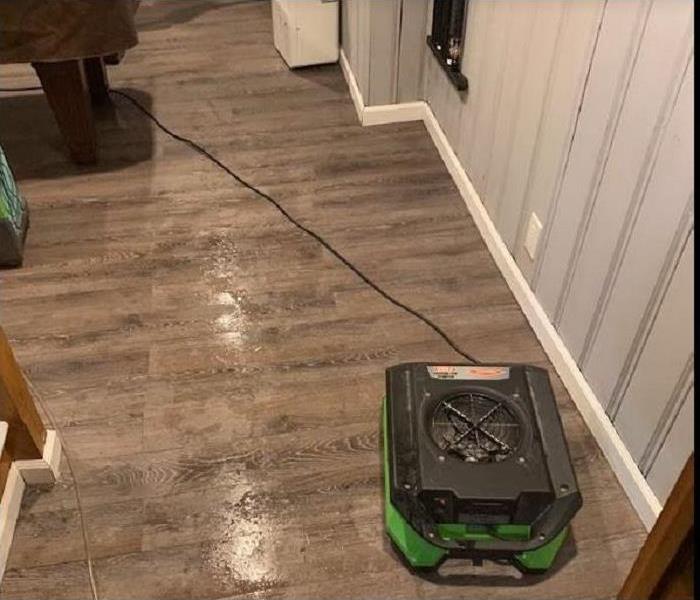Can Water Intrusion or Flooding in Oceanside Lead to Microbial Growth?
5/14/2020 (Permalink)
Water Incidents in Oceanside can provide the Conditions for Uncontrolled Growth of Bacteria, Viruses, and Mold
Oceanside properties are at a high risk of water intrusion and should seek professional assistance to limit secondary harm.
What are the leading causes of water intrusion for beachfront properties?
Homeowners may frequently require professional water removal services here in Oceanside. Proximity to the sea can increase the chances of groundwater eruption, saltwater intrusion, and floods. Sometimes these situations are linked to weather conditions like heavy rainfall, which can raise the groundwater level. Groundwater levels can also heighten when water from the sea enters the bay, a phenomenon known as a saltwater intrusion.
How can I tell if my home is victim to groundwater intrusion?
Groundwater travels in aquifers beneath the ground. These aquifers can overflow, which causes water to rise through the soil and reach the surface level. When water tables reach a certain height, they can begin to affect your property, starting in the foundations, moving up through crawlspaces, and, eventually, moving up through floors on the ground level. Controlling this type of water intrusion can be challenging because systematic methods, such as blocking entranceways, is less effective. In many cases, drains are unable to transport water away from the street or property because they, too, are overflowing. We offer water restoration technicians to oceanside residents that require emergency draining of the property as well as the transportation and disposal of large amounts of groundwater.
What makes groundwater flooding different from other types of water intrusion?
- Water rises from the ground, rather than from rainfall or a water source like a burst dam
- Groundwater brings silts, debris, and muds into the home, so we classify it as a blackwater emergency
- Crawlspaces, foundations and subterranean areas of the house are the most affected by groundwater flooding
- It can be challenging to drain properties in areas where aquifers are overflowing as they can limit the effectiveness of sewer and plumbing systems
- There can be significant water migration into cavities and subfloors which are tough to dry out due to restricted accessibility for equipment
What professional services should I look for to restore groundwater intrusion?
When waters in Oceanside rise from the ground, they can cause significant harm in the structural cavities of your property. Particular areas of concern can be the subfloor, which is usually constructed of wood or concrete and can be adversely affected by water exposure leading to mold, warping or cupping of frames and jointing. Our roster of technicians at SERVPRO includes applied structural drying technicians (ASD) who are experts at finding and removing moisture from hard to reach areas. ASD technicians have an essential skillset for dealing with water intrusion.
How do I dry out the cavities of my home after water intrusion?
Your home is full of cavities that ventilate, structure, and store materials like sheetrock. These areas of the house can suffer significantly with water intrusion, which can lead to mold growth, rotting, and structural harm. There are physical barriers to restoring cavities as well, like drywall. Our technicians can perform a controlled demolition to remove obstacles and gain access to structural cavities temporarily. We can then circulate warm air into these areas to dry them thoroughly and reduce the chances of mold growth.
How can I find out if there is water migration into cavities?
- You can place moisture sensors onto the wall's surface, which measures the temperature and provides an accurate reading water levels behind the wall.
- You can probe the subfloor of your home by using a moisture meter. You can also use moisture meters to assess the water content of materials
- Boroscopes provide exact information on cavity conditions. However, they do require some invasive procedures. Drill small holes into the wall to feed the boroscope behind drywall.
- Hire thermal imaging cameras to assess larger areas of the wall without having to remove drywall
- Remove small sections of drywall or carpet pads to perform a visual inspection of the cavity. Removal of physical barriers can aid in the drying process
Can you drywall cavities without demolishing drywall or remove flooring?
Some equipment like injectidry systems is less invasive when drying wall cavities. SERVPRO technicians drill small holes beneath the baseboard of the home. They can then attach injector nozzles to the wall and circulate warm air into the cavity. Floors can benefit from placing drying mats onto the floor. This equipment covers a larger surface area and uses a centrifugal vacuum to draw moisture out of the subfloor without removing it.
Water intrusion in your property can cause water migration into wall cavities. Without proper restoration, these cavities can become hotbeds for microbial activity, commonly leading to mold growth. By enlisting ASD technicians, you can ensure that these hard to reach areas receive appropriate drying treatment and limit the secondary losses to your home.
For specialist cavity drying technicians, contact SERVPRO of Long Beach / Oceanside at (516) 536-1801.






 24/7 Emergency Service
24/7 Emergency Service
